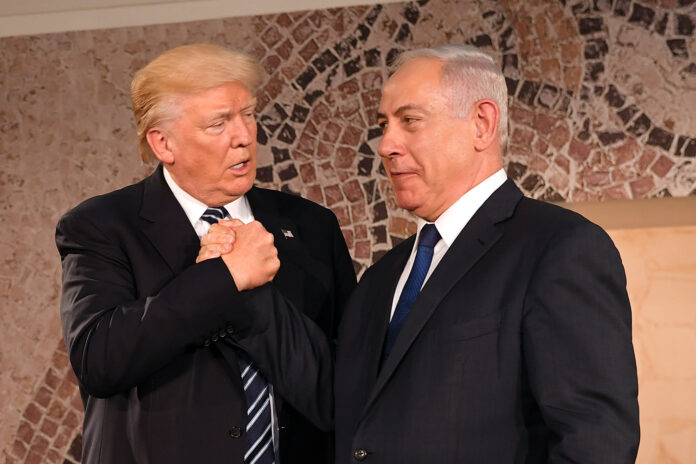For socialists and workers’ organisations against the war, stepping up the mass international antiwar movement is extremely urgent
Per-Åke Westerlund, ISA International Political Committee
(This article was first published on 18 June 2025)
After 5 days of war, Netanyahu and Trump both ordered the entire population of Tehran to evacuate, stressing Israel’s military superiority and “control of the skies”. The latest reports cite over 220 dead civilians in Iran while 24 are reported dead from Tehran’s retaliatory attacks. At the same time, the genocidal war on Gaza continues, with multiple reports of starving Palestinians being callously gunned down by the IDF.
A scared population, in the Middle East and around the world, now awaits the next stage of the carnage as speculation mounts that Trump is about to drag the US fully into the war. He has mobilised more attack capability to the region, and increased his war-mongering rhetoric, demanding “unconditional surrender” from Iran. US imperialism joining the attacks on Iran will mean a full blown regional war with global consequences on every field including the economy, political crisis and struggles from below.
For socialists and workers’ organisations against the war, stepping up the mass international antiwar movement is extremely urgent. Escalation is required, including strikes, and organized boycotts of arms transportation, alongside mass demonstrations against war and militarism. Relying on the strength of the working class and translating it into organization and action is the only way to stop wars and address the capitalist and imperialist root causes of today’s militarist and authoritarian turn by ruling classes in the Middle East and beyond. This means struggle against all imperialist forces and their regimes.
Iran under all-out attack
In Tehran, news agencies report that the bulk of the population is trying to leave the city, despite the authorities ordering them to stay. With residential areas hit by bombs, propaganda from Trump about looming hellish attacks, and a lack of proper shelters, families that can do so are rushing to cars and other forms of transport, taking “final” pictures of their homes before fleeing. Queues at petrol stations and on roads can take 14 hours or more to navigate. At the same time, a large share of the population living in poverty have no cars or means to leave the city.
Iran is facing an all-out attack from the Israeli state, against nuclear facilities, missile launch systems and storage, public television and communications, top state and military leaders, and increasingly against energy depots and production. Netanyahu’s extreme right-wing government in Israel and its military leaders have indicated that intense bombing will continue for another two weeks or more. Officially 224 civilians have been killed and 1,277 wounded by attacks on Tehran and Isfahan, as well as a number of other cities from Tabriz in the north to Bashehr Asalyuyeh in the south. One human rights group has said that 406 have been killed.
Netanyahu knew Iran would retaliate in a different way than in April and October last year, when its targets were mainly military. Reports in Israeli media say the government’s decision to attack counted on a “worst case scenario” of 800–4,000 dead in Israel. So far, three workers were killed at Haifa oil refinery, with victims also in Tamra in the north, Bat Yam in Tel Aviv district and Petah Ttikva in central Israel. Officially 24 have been killed inside the “Green line”, with 592 wounded.
Militarily, Israel clearly has the upper hand so far. Netanyahu claims to have total control of Iranian air space, and Iran’s missile launch capacity has been blunted. Israeli bombings and missile hits have been much more intense and deadly, and have inflicted significant losses on Iran’s military leadership through assassinations. The Iranian regime is shaken, but has no alternative than to hit back.
Trump prepares to go to war
Netanyahu has long argued Iran was very close to achieving nuclear arms and therefore should be attacked. While this attack was planned for a long time, a clear opportunity to act opened up with the Trump presidency. “We now understand that all the media reports of recent weeks of severe disagreements between Washington and Jerusalem were a charade. Israel never had any plans to surprise the United States or attack Iran against the will of the United States. Donald Trump was informed in advance and made no objections”, Swedish commentator Nathan Shahar pointed out.
This does not mean the interests of the Israeli government and the White House are identical. Trump did not participate in the first attacks. One reason was his hope to keep the Gulf States as close allies. All of the region’s regimes have condemned Israel’s attack, for fear of the consequences militarily, as well as for the economy and the risk of social unrest. The only exception is the new regime in Syria, who have not officially commented on the war and basically broadcasts Israeli propaganda on its state television network. However, this consideration seems to be weighing less and less in Trump’s calculations as he loudly threatens to step into the war. Trump may hope that a war shortened by US intervention, and a weakened Iran can avoid irreparable damage to his relations with Saudi Arabia and other Gulf States.
While the Israeli regime triumphantly boasts of its successes, it also openly admits its need for US intervention to “finish the job”. Key to this is its incapacity to destroy the alleged underground nuclear facilities in Fordrow, located deep inside a mountain. Only US “bunker buster” bombs, which weigh 30,000 lbs — the biggest non nuclear bomb known to exist — are believed to be strong enough to destroy the mountain protection, and even they would reportedly require multiple impacts in the same spot to do so.
Current indications suggest that Trump is indeed preparing the ground to join the war directly. However, this course of action will be fraught with political problems domestically. A majority of the US population are opposed, and a powerful section of MAGA supporters, including high profile Trump acolytes like Steve Bannon and Tucker Carlson, are attached to the narrative that Trump is a “peace president” that will not engage in foreign wars. To appease this layer, Trump may try to justify intervention on grounds of “US national security”, by echoing Netanyahu’s propaganda about the danger of an Iranian nuclear weapon. On 17 June, he publicly rubbished his own intelligence agencies’ assessment that the Iranian regime was not building a nuclear weapon, telling reporters “I don’t care what she said”, referring to Director of National Intelligence, Tulsi Gabbard.
US imperialism participating directly — though it has, of course, already supported Israel with intelligence and by intercepting Iranian missiles — would mean that the Tehran dictatorship would almost certainly have to respond by attacking US targets in the region. It could also target infrastructure in the Gulf States, as it did in 2019, when attacks in response to US aggression dealt terrible blows to Saudi oil production. Another significant escalatory step from Iran would be the closing of the Strait of Hormuz, through which one third of the world’s seabound oil is shipped. Though Tehran’s “axis of resistance” has been severely decimated in the last year, it can still count on the assistance of the Houthis in Yemen and allied militias in Iraq and Syria.
No quick solution for Israeli regime or US imperialism
What Trump seems to hope for is Tehran’s total capitulation. However, even this would not achieve the war aims of Netanyahu. If the regime is not toppled, the possibility of Iran developing nuclear arms would remain, and likely increase as a consequence of this war. The idea that US warplanes could conduct a few raids and “solve the problem” is a complete illusion.
For Netanyahu’s extreme-right government, the war is about regional power. In Gaza, more than 300 people have been killed in the last days by Israeli soldiers when desperately trying to get food in a society strangled to starvation. In the West Bank, ethnic cleansing and increased violence by Israel’s military is being stepped up. In both areas, the Israeli state has sharply increased the areas it directly occupies in recent months.
Netanyahu is also fighting for his government’s survival. His warfare is supported by the official opposition parties, and his attacks on Iran immediately silenced the hypocritical and tokenistic complaints by European governments who in recent weeks, after 20 months of complicity, made some noises about starvation and bombing of Gaza. The G7 meeting in Canada yesterday stated “Israel’s right to defend itself” and Iran as “the principal source of regional instability and terror.”
Netanyahu’s hubris, a trait shared with Trump, will backfire on him. For 20 months, his regime has declared that the murderous attacks on Gaza were bringing Israel close to full victory. But time will tell that this is far from the truth — Netanyahu and Trump’s bloody onslaught is preparing the ground for new generations of further resistance to Israeli aggression and US imperialism, in the region and globally. Opposition to these wars will continue to grow, including within Israeli society, which has already seen outbreaks of mass opposition to the government’s policy in wartime.
Perspectives for what lies ahead should still be conditional. Celebrations of military victory can be premature, as shown by George W. Bush’s war in Afghanistan and Iraq. Wars and the imposition of imperialist proxy regimes will inevitably lead to resistance. In Iraq and Afghanistan, with the lack of an organised working class and left forces on the ground, US imperialism’s wars opened the way for Islamic State and the return of the Taliban.
Build mass struggle against war and imperialism
In Iran in recent years, protest movements of workers and youth, particularly young women, alongside oppressed nationalities, have shown a way to overthrow the regime if the struggles are united armed with a clear socialist programme. They are in no way assisted by a military onslaught from Netanyahu and Trump, quite the contrary.
There is no solution to this seemingly endless bloodbath on the basis of military campaigns conducted by any imperialist power or any reactionary regime in the Middle East. The only road forward is one of mass working class struggle against Israeli capitalism and US imperialism, and against the capitalists regimes which exploit and repress workers, women, and oppressed nationalities and minorities throughout the region. Working class organizations must come together in struggle across borders and communities to fight for a shared future of freedom from occupation and imperialism, full democratic and national rights, and public democratic ownership and control over wealth and resources. This can lay the basis for socialist change, in the interests of all the peoples of the Middle East, as part of a struggle for a socialist world.




